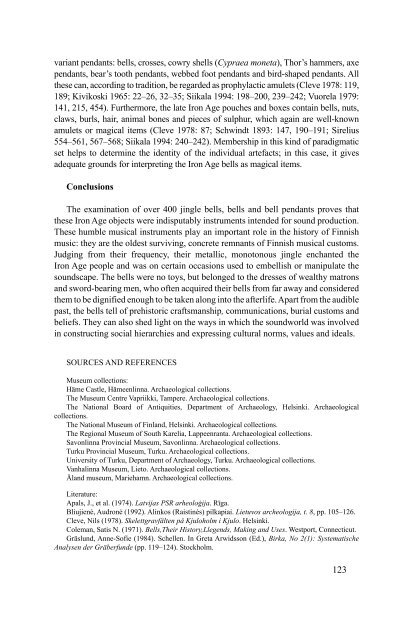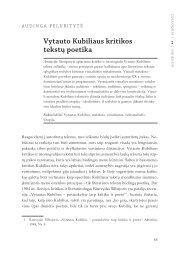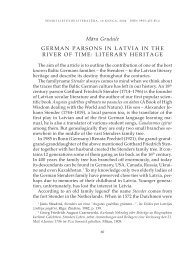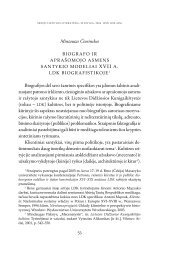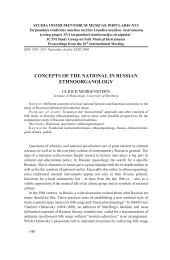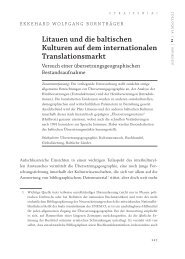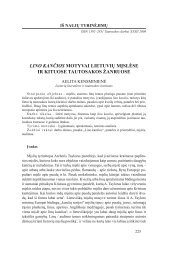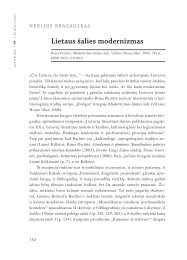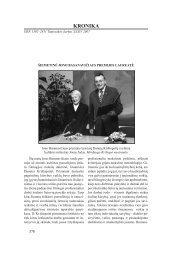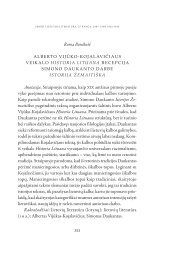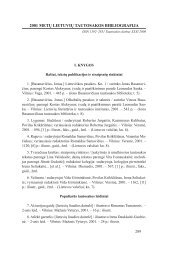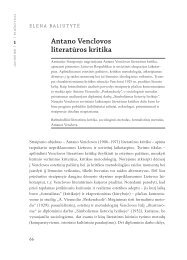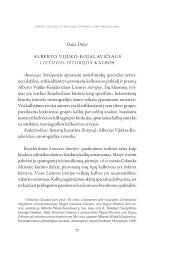tautosakos darbai xxxii - Lietuvių literatūros ir tautosakos institutas
tautosakos darbai xxxii - Lietuvių literatūros ir tautosakos institutas
tautosakos darbai xxxii - Lietuvių literatūros ir tautosakos institutas
You also want an ePaper? Increase the reach of your titles
YUMPU automatically turns print PDFs into web optimized ePapers that Google loves.
variant pendants: bells, crosses, cowry shells (Cypraea moneta), thor’s hammers, axe<br />
pendants, bear’s tooth pendants, webbed foot pendants and b<strong>ir</strong>d-shaped pendants. all<br />
these can, according to tradition, be regarded as prophylactic amulets (Cleve 1978: 119,<br />
189; kivikoski 1965: 22–26, 32–35; siikala 1994: 198–200, 239–242; vuorela 1979:<br />
141, 215, 454). Furthermore, the late <strong>ir</strong>on age pouches and boxes contain bells, nuts,<br />
claws, burls, ha<strong>ir</strong>, animal bones and pieces of sulphur, which again are well-known<br />
amulets or magical items (Cleve 1978: 87; schwindt 1893: 147, 190–191; s<strong>ir</strong>elius<br />
554–561, 567–568; siikala 1994: 240–242). Membership in this kind of paradigmatic<br />
set helps to determine the identity of the individual artefacts; in this case, it gives<br />
adequate grounds for interpreting the <strong>ir</strong>on age bells as magical items.<br />
Conclusions<br />
the examination of over 400 jingle bells, bells and bell pendants proves that<br />
these <strong>ir</strong>on age objects were indisputably instruments intended for sound production.<br />
these humble musical instruments play an important role in the history of Finnish<br />
music: they are the oldest surviving, concrete remnants of Finnish musical customs.<br />
Judging from the<strong>ir</strong> frequency, the<strong>ir</strong> metallic, monotonous jingle enchanted the<br />
<strong>ir</strong>on age people and was on certain occasions used to embellish or manipulate the<br />
soundscape. the bells were no toys, but belonged to the dresses of wealthy matrons<br />
and sword-bearing men, who often acqu<strong>ir</strong>ed the<strong>ir</strong> bells from far away and considered<br />
them to be dignified enough to be taken along into the afterlife. apart from the audible<br />
past, the bells tell of prehistoric craftsmanship, communications, burial customs and<br />
beliefs. they can also shed light on the ways in which the soundworld was involved<br />
in constructing social hierarchies and expressing cultural norms, values and ideals.<br />
sourCes aNd reFereNCes<br />
Museum collections:<br />
Häme Castle, Hämeenlinna. archaeological collections.<br />
the Museum Centre vapriikki, tampere. archaeological collections.<br />
the national Board of antiquities, department of archaeology, Helsinki. archaeological<br />
collections.<br />
the national Museum of Finland, Helsinki. archaeological collections.<br />
the regional Museum of south karelia, Lappeenranta. archaeological collections.<br />
savonlinna Provincial Museum, savonlinna. archaeological collections.<br />
turku Provincial Museum, turku. archaeological collections.<br />
university of turku, department of archaeology, turku. archaeological collections.<br />
vanhalinna Museum, Lieto. archaeological collections.<br />
Åland museum, Mariehamn. archaeological collections.<br />
Literature:<br />
apals, J., et al. (1974). Latvijas PSR arheoloģija. rīga.<br />
Bliujienė, audronė (1992). alinkos (raistinės) pilkapiai. Lietuvos archeologija, t. 8, pp. 105–126.<br />
Cleve, nils (1978). Skelettgravfälten på Kjuloholm i Kjulo. Helsinki.<br />
Coleman, satis n. (1971). Bells,The<strong>ir</strong> History,Llegends, Making and Uses. Westport, Connecticut.<br />
gräslund, anne-sofie (1984). schellen. in greta arwidsson (ed.), B<strong>ir</strong>ka, No 2(1): Systematische<br />
Analysen der Gräberfunde (pp. 119–124). stockholm.<br />
123


